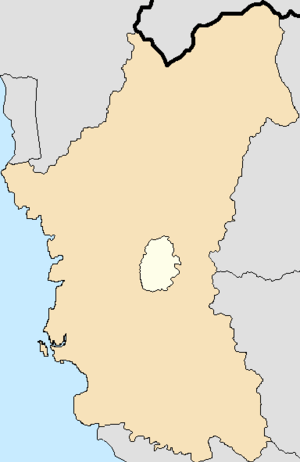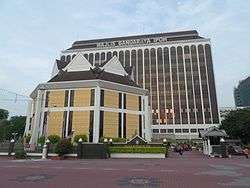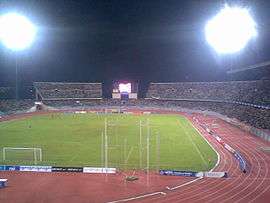Ipoh
Ipoh (/ˈiːpoʊ/) is the capital city of the Malaysian state of Perak. Located by the Kinta River, it is nearly 180 km (110 mi) north of Kuala Lumpur and 123 km (76 mi) southeast of George Town in neighbouring Penang. As of 2010, Ipoh had a population of 657,892, making it the third largest city in Malaysia by population.[2]
Ipoh | |
|---|---|
City and state capital | |
| City of Ipoh Bandaraya Ipoh | |
| Other transcription(s) | |
| • Jawi | إڤوه |
| • Chinese | 怡保 |
| • Tamil | ஈப்போ |
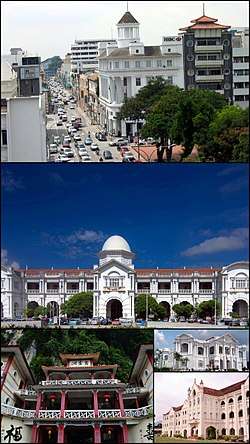 Clockwise from top: Jalan Tun Sambanthan within the Old Town, Railway Station, City Hall, St. Michael's Institution, Perak Tong Temple | |
 Flag 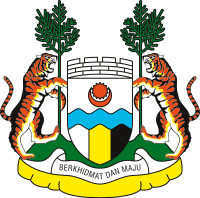 Seal | |
| Nickname(s): City of Millionaires, Bougainvillea City, Silver Valley | |
| Motto(s): Ipoh Bersih, Hijau dan Maju (English: Ipoh Clean, Green and Progressive) | |
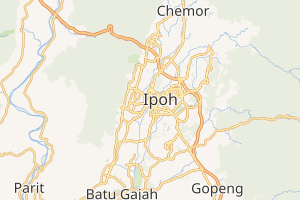
Location of Ipoh in Perak | |
| Coordinates: 04°35′50″N 101°04′30″E | |
| Country | |
| State | |
| Establishment | Around 1880 |
| Granted States Capital status | 31 May 1937 |
| Granted Municipality status | 31 May 1962 |
| Granted City status | 27 May 1988 |
| Government | |
| • Mayor | Rumaizi Baharin |
| Area | |
| • City and state capital | 643 km2 (248 sq mi) |
| Elevation | 21.95 m (72 ft) |
| Population (2010) | |
| • City and state capital | 657,892 |
| • Density | 1,023/km2 (2,650/sq mi) |
| • Metro | 737,861[1] |
| Time zone | UTC+8 (MST) |
| • Summer (DST) | Not observed |
| Postcode | 30xxx, 31xxx |
| Area code(s) | 05 |
| Website | mbi |
Originally a village, Ipoh began to grow rapidly in the 1880s after huge deposits of tin were discovered within its vicinity.[3] By 1895, it was the second largest town within the Federated Malay States, which also consisted of Selangor, Negeri Sembilan and Pahang.[4] Ipoh was declared a city in 1988.[3][4] However, following the depletion of its tin deposits and the collapse of tin prices in the 1970s, the city suffered decades of decline and neglect.[5][6][7][8]
In recent years, Ipoh's popularity as a tourist destination has been significantly boosted by efforts to conserve its British colonial-era architecture.[7][8] The city is also well known for its cuisine and natural attractions, such as its limestone hills and caves within which Buddhist temples were built.[9] In addition, Ipoh has managed to maintain its reputation as one of the cleanest cities in Malaysia.[10]
Ipoh's location between Kuala Lumpur and George Town has made it a major land transportation hub within West Malaysia, with both the Malayan Railway's West Coast Line and the North-South Expressway cutting through the city. Aside from the land transportation links, Ipoh is also served by the Sultan Azlan Shah Airport.
Ipoh is known as the Hipster Capital of Malaysia by various tourism rating and official agencies.[11][12][13][14]
Etymology
The name Ipoh is derived from a local tree, Pohon Epu, now more commonly known as Pokok Ipoh. The sap of this plant is poisonous and was used by Orang Asli (indigenous peoples in Malay) to coat the tips of the darts of their blowpipes for hunting.
History
Ipoh grew out from the Malay village of Paloh along the banks of the Kinta River in the 1880s.[3] Its geographic location in the rich tin-bearing valley of the Kinta River made it a natural centre of growth.
The Great Fire of Ipoh in 1892 destroyed over half the town, but also presented an opportunity to rebuild the town in a more orderly grid pattern. Ipoh was subsequently rebuilt in time for the second tin rush and grew rapidly as a result of the booming tin mining industry, particularly in the 1920s and 1930s.
A local Hakka miner, millionaire Yau Tet Shin, started developing a large tract of the town in the early 1930s, today known as the "New Town", from the eastern bank of the Kinta River to Greentown.[15] In 1937, Ipoh was made the capital of Perak, replacing Taiping.
Ipoh was invaded by the Japanese on 15 December 1941. In March 1942, the Japanese Civil Administration or Perak Shu Seicho was set up at the St. Michael's Institution. After the liberation of Malaya by British forces, Ipoh remained the capital of Perak as it does to this day.[16]
The decline of the tin mining industry during the latter half of the 20th century caused the growth of Ipoh to stagnate. With the closure of the tin mines, its urban population was forced to seek employment in other cities within Malaysia. In spite of this, Ipoh remains one of the largest cities in Malaysia in terms of population, with tourism now a main driver of the city's economy.[17]
Ipoh gained Municipal status in 1962, and in 1988 it was declared a city by the then Sultan of Perak, Sultan Azlan Shah.[3]
Geography
Topography
Ipoh is in the state of Perak, which is in the northern part of Peninsular Malaysia. The city is in the middle of the Kinta Valley, on the bank of the Kinta River and the confluence of the smaller rivers Sungai Pinji and Sungai Pari. The city is surrounded by limestone hills, which can be found around suburban areas to the northeast, east and southeast.[18]
The Kledang mountain range stretches from the north to the west of the city. This range runs parallel to the Bintang mountain range with the Perak River running on its left bank and the Kinta River to its right. This range is interrupted to the north of Ipoh by a tributary of the Perak River called the Pelus River, which is sourced from the Titiwangsa mountain range, which runs to the east of Ipoh.[19]
Climate
Ipoh has a tropical rainforest climate. Ipoh is more subject to the Intertropical Convergence Zone than the trade winds and very rarely has cyclones, therefore it can be described as having an equatorial climate. The city's temperature shows little variation throughout the year, the average temperature being 28 °C (82 °F). Ipoh sees high precipitation throughout the year with an average of 200 mm (7.9 in) of rain each month and averaging 2,427.9 mm (95.59 in) of rain per year. The wettest month is October when on average 297.2 mm (11.70 in) of rain falls. Ipoh's driest month is January which has 132.3 mm (5.21 in) of rainfall on average.
| Climate data for Ipoh | |||||||||||||
|---|---|---|---|---|---|---|---|---|---|---|---|---|---|
| Month | Jan | Feb | Mar | Apr | May | Jun | Jul | Aug | Sep | Oct | Nov | Dec | Year |
| Average high °C (°F) | 32.9 (91.2) |
33.7 (92.7) |
33.9 (93.0) |
33.7 (92.7) |
33.5 (92.3) |
33.3 (91.9) |
33.0 (91.4) |
33.0 (91.4) |
32.5 (90.5) |
32.4 (90.3) |
32.1 (89.8) |
32.1 (89.8) |
33.0 (91.4) |
| Average low °C (°F) | 22.6 (72.7) |
23.0 (73.4) |
23.4 (74.1) |
23.9 (75.0) |
24.0 (75.2) |
23.7 (74.7) |
23.2 (73.8) |
23.3 (73.9) |
23.2 (73.8) |
23.1 (73.6) |
23.1 (73.6) |
22.8 (73.0) |
23.3 (73.9) |
| Average rainfall mm (inches) | 132.3 (5.21) |
149.8 (5.90) |
169.9 (6.69) |
259.1 (10.20) |
210.9 (8.30) |
151.8 (5.98) |
156.6 (6.17) |
157.8 (6.21) |
216.0 (8.50) |
297.2 (11.70) |
275.4 (10.84) |
251.1 (9.89) |
2,427.9 (95.59) |
| Average rainy days (≥ 1.0 mm) | 9 | 10 | 12 | 14 | 14 | 10 | 10 | 12 | 15 | 18 | 18 | 15 | 157 |
| Source: World Meteorological Organisation[20] | |||||||||||||

Limestone caves
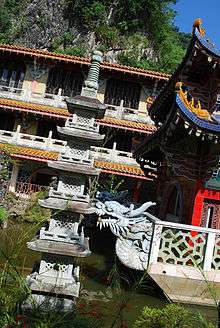

Limestone outcrops rise on the outskirts of Ipoh. There are many caves in these outcrops, some of which have cave temples built in them.[21] The Sam Poh Tong Temple (Chinese: 三宝洞) is a notable example, along with Kek Lok Tong (Chinese: 極乐洞; Cavern of Utmost Happiness), which lies on the other side of the same outcrop. It is accessible through the Gunung Rapat housing area. Other cave temples in Ipoh include Ling Sen Tong, Nan Tian Tong, Kwan Yin Tong and Perak Tong.
Gua Tempurung, near Gopeng, south of Ipoh, is a show cave open to the public and popular among spelunkers. More than 3 km (1.9 mi) long, it is one of the longest caves in Peninsular Malaysia. Part of it has been developed with electric lighting and walkways, and there are tours of varying lengths and difficulty. A river passage runs about 1.6 km (0.99 mi) through the hill. There are five large chambers, and stalactites and stalagmites.
Economy
In its early history, Ipoh as a settlement was built around its mining industry, although inferior to that of Gopeng, some 19 kilometres (12 mi) to the south. Ipoh was once one of the richest cities in Malaysia and South East Asia in the days when tin was its major product. During the 1980s, when tin prices collapsed, the economy of Ipoh was affected significantly. However, recently the city has experienced economic growth. The city of Ipoh also hosts some large multinational corporations. Kuala Lumpur Kepong Berhad, a palm oil company among the top 15 biggest companies in Malaysia by revenue, has its headquarters in Ipoh. Batu Kawan Berhad, an investment company which is the biggest shareholder in Kuala Lumpur Kepong Berhad, also has its headquarters in Malaysia. Ipoh houses the headquarters of Hovid Berhad, a pharmaceutical company which claims to be the first Malaysian company to introduce Malaysian generic drugs overseas. Old Town Berhad, which is a food and beverage public listed company specializing in white coffee, has its headquarters in Ipoh. There are other public listed companies in Ipoh such as Perak Transit Berhad, Tasek Cement Berhad, DKLS Industries Berhad, Wellcall Holding Berhad, Rubberex Berhad, and Perak Corp. Ipoh also hosts the Malaysian headquarters for some foreign multinational companies, including Finisar, Voith, ITL Asia Pacific and Sagami Manufacturers.
Governance
The Ipoh City Council governs the city. Datuk Rumaizi Baharin, appointed in April 2020, is the current mayor of Ipoh.[22]
Ipoh is divided into two parliamentary constituencies: Ipoh Barat (Ipoh West) and Ipoh Timur (Ipoh East). The parliamentary seat for Ipoh Timur is held by Democratic Action Party (DAP) Representative Su Keong Siong. It was formerly held by Lim Kit Siang. The seat for Ipoh Barat is held by fellow DAP leader M. Kulasegaran.[23]
Demographics
Ipoh remains one of Malaysia's largest cities. It is the third largest city in Malaysia. As of 2010, the municipal area of Ipoh has a population of 657,892.[24] It ranks as the seventh most populous urban centre in Malaysia (2010).[24]
The following is based on Department of Statistics Malaysia 2010 census.[24]
| Ethnic groups in Ipoh, 2010 | ||
|---|---|---|
| Ethnicity | Population | Percentage |
| Chinese | 290,165 | 44.11% |
| Bumiputera | 253,592 | 38.55% |
| Indian | 92,587 | 14.07% |
| Others | 1,559 | 0.2% |
| Non-Malaysian | 19,989 | 3.04% |
Cityscape
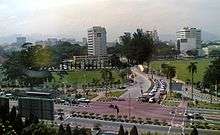
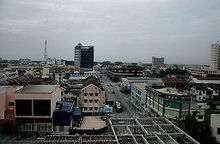
The Old Town
The Old Town lies to the west of the Kinta River. It has a commercial district with many historical "shop-houses" centred around Leech Street (Chinese: 烈治街; now Jalan Bandar Timah). Other notable features include:
- Ipoh railway station in neo-classical/Edwardian Baroque style nicknamed the "Taj Mahal of Ipoh".
- Ipoh Town Hall, an Edwardian Baroque municipal building located across the road from the Railway Station.
- Padang Ipoh or Ipoh Field, on Jalan S.P. Seenivasagam. The field is surrounded by historic buildings that feature classic colonial architecture, including the mock-Tudor style Ipoh Club, FMS Bar, HSBC Building and the St Michael's Institution secondary school.
- The Anglo-Chinese School, Ipoh, officially named SMK Methodist (ACS), is located along Lahat Road.
- Sekolah Menengah Kebangsaan Anderson is the most well-known secondary school with more than 100 years of history, located beside the General Hospital of Ipoh.
- St. Michael's Institution, Ipoh is a public secondary school situated on Jalan S. P. Seenivasagam, formerly Clayton Road.
- Han Chin Pet Soo, the Hakka Tin Miner's Club, located on Jalan Bijeh Timah (formerly Treacher Street) has been restored and turned into Malaysia's First Hakka Tin Mining Museum.
- Muzium Darul Ridzuan is a historical museum of Perak, in a former tin-mining tycoon's mansion on Jalan Kuala Kangsar.
- Concubine Lane (Chinese: 二奶巷), or better known locally as Yi Lai Hong in Cantonese, is a narrow and small lane located off Jalan Bandar Timah (Leech Street) in Old Town. It now has restaurants, souvenir and gift shops and a reputable hotel.
- Ipoh wall art murals, drawn by talented street art artists, are now a tourist attraction.
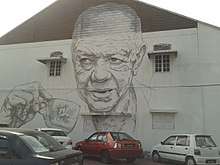
- Birch Memorial Clock Tower is a historical landmark which is located near the Ipoh State Mosque or commonly known as Sultan Idris Shah II Mosque. The clock tower was built to commemorate James W. W. Birch, the first British Resident in Perak who was killed on 2 November 1875 at Pasir Salak.
The New Town
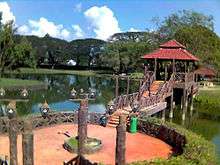
The so-called New Town, to the east of the Kinta River, was developed by Yau Tet Shin around 1908.[15] The New Town houses the Perak Medical University and Ipoh City Hall building. There are numerous shops, shopping malls, and hotels.
D. R. Seenivasagam Park (Coronation Park), located in the heart of Ipoh's New Town, is known for its scenery and recreational facilities. It comprises recreational fields, an artificial lake filled with fish, a nursery for potted plants and a children's traffic playground. The latest addition is the newly landscaped Japanese garden featuring a Japanese carp pond.
Culture
Cuisine
Ipoh has a significant food scene with many hawker centres and restaurants. It has dishes derived from Malay, Chinese and Indian cuisine. Ipoh is well known Sar Hor Fun (Chinese: 沙河粉), a complete one-dish rice noodle meal with prawn, meat, fish, vegetables and a savoury sauce. Other well-known dishes from Ipoh include Hor Hee (Chinese: 河嘻), flat white rice noodles served with fish cakes and/or fish balls; Nga Choi Kai (Chinese: 芽菜鸡), chicken with soy sauce and beansprouts topped with pepper; Kai Shi Hor Fun (Chinese: 鸡丝河粉), rice noodles with chicken; Hakka Mee (Chinese: 客家麵), yellow rice noodles served with mincemeat (pork) sauce; Tau Fu Fa (Chinese: 豆腐花), soybean pudding; and Ipoh's well-known pastry Heong Peng (Chinese: 香餅), literally translated to "fragrant biscuit". The city is known in Malaysia for its Ipoh white coffee, in which the coffee beans are roasted with palm-oil margarine and the resulting coffee is served with condensed milk. Ipoh is also known for its fresh fruits such as pomelo, durian and seedless guava. Ipoh is the home of Ipoh nasi kandar or Nasi Vanggey.
In recent years, Ipoh has seen an increase in international restaurants, bars and gastropubs which have become popular with locals and tourists.[25]
Film and television
Movies filmed in Ipoh include:
- 1992: Indochine
- 1999: Anna and the King
- 2003: Kadhal Kisu Kisu
- 2004: Tun Tan Cheng Lock
- 2005: Sepet
- 2005: Gubra
- 2006: After This Our Exile (父子)
- 2006: Goodbye Boys
- 2006: Lust, Caution (色,戒)
- 2015: Blackhat
Theme parks
There are several theme parks in Ipoh, including the Sunway Lost World of Tambun[26] and Movies Animated Park Studios (MAPS) temporarily closed due to the COVID-19 pandemic.[27]
Transport
- Trunk roads: The old interstate Route



- Highway: The new North–South Expressway

- Train: Ipoh's railway station is operated by Keretapi Tanah Melayu (KTM) and is in the Old Town. However, it does not have intra-city travel like there is in Kuala Lumpur; the railway only connects Ipoh with neighbouring towns and cities. The station is a stately building, referred to by locals as the "Taj Mahal of Ipoh". KTM Intercity began the Shuttle Train Service between Kuala Lumpur and Ipoh from 1 December 2008 while the modern Electric Train System (ETS) shuttle began from 12 August 2010, with an average speed of 145 km/h (90 mph), plying the Ipoh-Seremban route, which cut the travelling distance between Ipoh and Kuala Lumpur to 120 minutes. There are 10 dedicated shuttle train services between these two cities daily, beginning at 5 am from both of the stations. Travel time between the cities was expected to be reduced from three hours to two hours and fifteen minutes when the new set of EMU trains arrived in mid-2009.[28]
- Bus: The inter-city bus terminal is located at Amanjaya Integrated Bus Terminal in Bandar Meru Raya, just north of the city.
- Air: the Sultan Azlan Shah Airport is the only airport in Ipoh, located near Gunung Rapat. Domestic and international flights are available. Scoot and AirAsia provide daily flights from Ipoh to Singapore Changi Airport while Batik Air Malaysia provides daily flights to Senai International Airport, serving as a link to the city of Johor Bahru. There are also planned flights to Indonesia, Singapore, Thailand and China, with talks of a new airport soon.
Education
This is a list of schools in Ipoh, Perak.
- Sekolah Izzuddin Shah
- Sekolah Tuanku Abdul Rahman
- Sekolah Menengah Kebangsaan Tanjung Rambutan
- Sekolah Menengah Kebangsaan Seri Puteri
- Sekolah Jenis Kebangsaan (T) St. Philomena Convent, Ipoh
- Sekolah Kebangsaan Dato Panglima'Kinta, Ipoh
- Sekolah Jenis Kebangsaan (C) Yuk Choy, Ipoh (Chinese: 怡保育才小学)
- SMJK Yuk Choy, Ipoh (Chinese: 怡保育才中学)
- Tarcisian Convent School, Ipoh (TCS)
- Anderson School, Ipoh
- Anglo-Chinese School, Ipoh
- St. Michael's Institution, Ipoh
- SMK Jalan Tasek, Ipoh
- Methodist Girls Secondary School (MGS), Ipoh
- Perak Girls Secondary School (PGS), Ipoh
- SMK Main Convent, Ipoh
- Wesley Methodist School, Ipoh
- Ipoh International School (Private)
- Fairview International School, Ipoh
- Perak Yuk Choy High School (Private), Ipoh
- Poi Lam High School (Private), Ipoh (Chinese: 怡保培南独立中学)
- Shen Jai High School (Private), Ipoh (Chinese: 怡保深斋独立中学)
- Sekolah Jenis Kebangsaan (TAMIL) Kerajaan, Sungai Pari, Ipoh
- Sekolah Jenis Kebangsaan (TAMIL) Gunung Rapat, Ipoh
- Sekolah Jenis Kebangsaan (TAMIL) Perak Sangeetha Sabha, Ipoh
- SMK Rapat Setia, Ipoh
- SMK Jalan Pasir Puteh, Ipoh
- Sekolah Jenis Kebangsaan (C) Poi Lam, Ipoh
- SMK Seri Keledang, Ipoh
- SMK Menglembu, Ipoh
- SMJK Poi Lam, Ipoh
- Sekolah Jenis Kebangsaan (C) Sam Tet, Ipoh (Chinese: 怡保三德小学)
- SMJK Sam Tet, Ipoh (Chinese: 怡保三德中学)
- SMK Dato Ahmad Said
- Sekolah Jenis Kebangsaan Ave Maria Convent, Ipoh (Chinese: 怡保圣母玛利亚小学)
- SMJK Ave Maria Convent, Ipoh (Chinese: 怡保圣母玛利亚国民型中学)
- Sekolah Jenis Kebangsaan (C) Gunung Rapat, Ipoh
- Sekolah Jenis Kebangsaan (C) Wan Hwa (1) (Chinese: 怡保万华小学一校)
- Sekolah Jenis Kebangsaan (C) Wan Hwa (2) (Chinese: 怡保万华小学二校)
- Sekolah Kebangsaan (ACS), Ipoh
- Sekolah Kebangsaan (P) Methodist, Ipoh
- Sekolah Kebangsaan Haji Mahmud Chemor, Ipoh
- Sekolah Kebangsaan Kuala Pari, Ipoh
- Sekolah Kebangsaan Jalan Pegoh
- Sekolah Kebangsaan Jelapang
- Sekolah Kebangsaan Marian Convent,Ipoh
- Sekolah Kebangsaan Raja Ekram, Ipoh
- SMK Raja Perempuan, Ipoh (RPS) Royal Princess School "Cluster School"
- SRK Raja Perempuan, Ipoh (RPS)
- Sekolah Kebangsaan Seri Ampang, Ipoh
- Sekolah Kebangsaan St. Michael's Institution (1), Ipoh
- Sekolah Kebangsaan St. Michael's Institution (2), Ipoh
- Sekolah Jenis Kebangsaan (C) Chung Shan
Sports
Ipoh has a sports complex known as Kompleks Sukan MBI or MBI Sports Complex. Among the facilities located within the complex is the Perak Stadium (Malay: Stadium Perak), the home of Perak Football Association who play in the Malaysia Super League.
Golf courses in Ipoh include the Royal Perak Golf Club off Jalan Sultan Azlan Shah (Tiger Lane), the Meru Golf Club in Jelapang, and Clearwater Sanctuary Golf Club en route to Batu Gajah.
Other sports venues include the Kilat Club in Pasir Pinji, Ipoh Field (Padang Ipoh) in the Old Town, the Polo Grounds, and the Iskandar Polo Club in Ampang Baru.
The Sultan Azlan Shah Cup is an annual international men's field hockey tournament held in Ipoh.
Notable people
Film and television
- Angie Cheong, actress
- Mimi Chu, actress and singer
- Iqram Dinzly, actor and model
- Mamat Khalid, film director and screenwriter
- Peter Pek, TV host and businessman
- Afdlin Shauki, screenwriter, director and actor
- Patrick Teoh, actor and radio host
- Michelle Yeoh, actress famous for role in Crouching Tiger, Hidden Dragon
- Natasha Hudson, actress and model
Music
- Michael Wong, singer-songwriter
- Jamal Abdillah, pop singer and actor
- Shila Amzah, singer-songwriter and actress
- Ning Baizura, pop and R&B singer, actress
- Francissca Peter, singer-songwriter
- Sophia Liana
- Sam Chin Neng of pop duo Fuying & Sam
Sports (badminton)
Sports (football)
Sports (others)
- Tony Underwood (rugby)
- Nur Suryani Mohd Taibi (sports shooting)
- Leong Mun Yee (diving)
- Cheong Jun Hoong (diving)
Business
- David Ho Sue San of Hovid Berhad and Carotech Berhad
- Lee Loy Seng, founder of Kuala Lumpur Kepong Berhad
- Dr. Wong Jeh Shyan, CEO of CommerceNet Singapore Limited
- Koon Yew Yin, founder of IJM Corporation Bhd and Gamuda Berhad
- Leong Sin Nam, tin mine owner
- Eu Tong Sen, tin mine owner
- Foo Choo Choon, tin mine owner who has a road in Ipoh named after him
- Chung Thye Phin, tin mine owner who has a road in Ipoh named after him
- Leong Fee, tin mine owner
Politics
- Yeoh Ghim Seng, Speaker of the Parliament of Singapore 1970–1989
- Dr Yeoh Eng Kiong, Hong Kong Secretary for Health, Welfare and Food 2002–2004
- S. J. V. Chelvanayakam, Member of the Ceylonese Parliament 1956–1977
- Ahmad Husni Hanadzlah, Second Minister of Finance of Malaysia 2009–2016
- D. R. Seenivasagam, co-founder of the People's Progressive Party
- Lim Keng Yaik, president of the Malaysian People's Movement Party 1980–2007
- Lee Lam Thye, social activist and former politician
- Chang Lih Kang, Malaysian politician
- Lee Chuan How, Member of the Perak State Executive Council 2018–2020
- Yusof bin Ishak, president of Singapore 1965–1970
Other
- Chan Sek Keong, Chief Justice of Singapore 2006–2012
- Lat, cartoonist
- Huen Su Yin, blogger and cake designer
- Tang Siew Mun, academic
- Tang Tuck Kan, artist
- Wu Lien-teh, physician during the Manchurian Plague
Media
Nationwide daily newspapers
Malay
English
Chinese
- Nanyang Siang Pau (南洋商报)
- Sin Chew Daily (星洲日报)
- China Press (中国报)
Tamil
- Makkal Osai (மக்கள் ஓசை)
- Malaysia Nanban (மலேசியா நண்பன்)
Ipoh terrestrial channels
Ipoh free-to-air stations include:
| Television station | Channel | Network | Broadcast area | Broadcast hour |
|---|---|---|---|---|
| TV1 (HD) | 101 | RTM | Nationwide | 24/7 |
| TV2 (HD) | 102 | |||
| TV3 (HD) | 103 | Media Prima | ||
| CJ WOW Shop Malay | 104 | |||
| Drama Sangat | 105 | |||
| CJ WOW Shop Chinese | 106 | |||
| NTV7 | 107 | 06:00-02:00 MST (21-Hours) | ||
| 8TV | 108 | |||
| TV9 | 109 | 24/7 | ||
| TV Okey (HD) | 110 | RTM | ||
| RTM Sports (HD) | 111 | |||
| Awesome TV (HD) | 112 | Awesome Media Network | ||
| TV Alhijrah (HD) | 114 | Alhijrah Media | ||
| Astro GO Shop Malay (HD) | 120 | Astro | ||
| Bernama | 121 | Bernama | ||
| Berita RTM (HD) | 123 | RTM |
Astro Ipoh
Malaysian satellite television provider Astro provides the following channels in Ipoh:
- Astro AEC
- Astro Arena
- Astro Aura
- Astro Awani
- Astro Ceria
- Astro Citra
- Astro Hua Hee Dai
- Astro Oasis
- Astro Prima
- Astro Rania
- Astro Ria
- Astro SuperSport
- Astro SuperSport 2
- Astro SuperSport 3
- Astro SuperSport 4
- Astro Shuang Xing
- Astro TVIQ
- Astro Vaanavil
- Astro Vellithirai
- Astro Warna
- Astro Xiao Tai Yang
Radio
The available FM radio stations in Ipoh, both public (including Ipoh-based Perak FM) and commercial, are as listed below.
| Frequency | Station | Operator | Language |
|---|---|---|---|
| 87.6 FM | One FM | Media Prima | Chinese (Mandarin, Cantonese) |
| 87.9 FM | Fly FM | Media Prima | English, Malay |
| 88.3 FM | Radio Klasik FM | RTM | Malay |
| 88.5 FM | Nasional FM | RTM | Malay |
| 90.1 FM | TraXX FM | RTM | English |
| 90.9 FM | Nasional FM | RTM | Malay |
| 92.1 FM | Ai FM | RTM | Chinese (Mandarin, various Chinese dialects) |
| 92.7 FM | Hitz | Astro Radio | English |
| 94.3 FM | Mix | Astro Radio | English |
| 95.6 FM | Perak FM | RTM | Malay |
| 96.0 FM | Suria FM | Star Rfm | Malay |
| 96.9 FM | Sinar | Astro Radio | Malay |
| 97.9 FM | Raaga | Astro Radio | Tamil |
| 98.5 FM | Melody | Astro Radio | Chinese |
| 98.8 FM | 988 FM | Star Rfm | Chinese (Mandarin, Cantonese) |
| 98.9 FM | Minnal FM | RTM | Tamil |
| 100.6 FM | My | Astro Radio | Chinese (Mandarin, Cantonese) |
| 101.5 FM | Lite | Astro Radio | English |
| 103.7 FM | Era | Astro Radio | Malay |
| 104.5 FM | Hot FM | Media Prima | Malay |
| 106.4 FM | Zayan | Astro Radio | Malay |
Sister cities
Ipoh currently has two sister cities:
See also
References
- "Archived copy" (PDF). Archived from the original (PDF) on 21 May 2012. Retrieved 21 March 2015.CS1 maint: archived copy as title (link)
- "Population Distribution by Local Authority Areas and Mukims, 2010 (page 1 & 8)" (PDF). Department of Statistics, Malaysia. Archived from the original (PDF) on 5 February 2015. Retrieved 19 July 2013.
- "The History of Ipoh" (PDF).
- "Info Ipoh: Halaman 2 dari 2 | Portal Rasmi Majlis Bandaraya Ipoh (MBI)". mbi.gov.my. Retrieved 21 August 2017.
- Tam, Susan. "Ipoh - Malaysia | The Star Online". Retrieved 21 August 2017.
- Tan, Peter (21 February 2015). "The city that tin built". BorneoPost Online | Borneo, Malaysia, Sarawak Daily News. Retrieved 21 August 2017.
- hermes (22 March 2016). "Sleepy Ipoh awakens". The Straits Times. Retrieved 21 August 2017.
- "Old Town restored to rightful place in history of Ipoh". theedgeproperty.com.my. Retrieved 21 August 2017.
- net, powered by iosc dot. "Ipoh Echo | Caves of the Kinta Valley". IpohEcho.com.my. Retrieved 21 August 2017.
- "Ipoh is Malaysia's cleanest city - Nation | The Star Online". thestar.com.my. Retrieved 21 August 2017.
- "Malay Mail - Ipoh Hipster Town Image". The Malay Mail.
- "SAYS". SAYS DOT COM.
- "The Star Malaysia". The Star Malaysia.
- "Time Travel Turtle". Time Travel Turtle.
- Ipohworld’s World » Yau Tet Shin’s New Town Under Construction 1908. Ipohworld.org. Retrieved 27 September 2013.
- Khoo Salma Nasution & Abdur-Razzaq Lubis, Kinta Valley: Pioneering Malaysia's Modern Development, Ipoh: Perak Academy, 2005. pp. 273–292
- "Ipoh History Facts and Timeline: Ipoh, Perak, Malaysia". world-guides.com. Retrieved 2 February 2017.
- "Limestone Hills (Bukit Batu Kapur), Ipoh, PERAK – Malaysia Travel Review". Malaysiahotelreview.com. Retrieved 10 December 2013.
- Jacq-Hergoualc'h, Michel; Victoria Hobson (September 2002). The Malay Peninsula: Crossroads of the Maritime Silk Road (100 BC – 1300 AD). BRILL. ISBN 90-04-11973-6.
- "World Weather Information Service – Ipoh". World Meteorological Organisation. Retrieved 7 May 2014.
- "Home". Cavesofmalaysia.com. Archived from the original on 6 July 2006. Retrieved 10 December 2013.
- "Rumaizi Baharin appointed new Ipoh mayor | The Star Online". The Star. Malaysia. Retrieved 1 June 2020.
- "M. Kulasegaran | Malaysia Parliament Portal". The Official Portal, Parliament of Malaysia Website. Malaysia. Retrieved 1 June 2020.
- "Population Distribution by Local Authority Areas and Mukims, 2010" (PDF). Department of Statistics Malaysia. Archived from the original (PDF) on 27 February 2012.
- "Ipoh's bars, gastropubs and nightlife". Travel-Tourist-Information-Guide.com. Retrieved 8 October 2016.
- "Lost World of Tambun Ipoh".
- "Movies Animation Park, Ipoh Official Website". Archived from the original on 7 February 2018.
- "Malaysia / Perak / The Ipoh Railway Station". Cockatoo.com. 14 November 2011. Archived from the original on 19 January 2013. Retrieved 10 December 2013.
- "Guangxi signed cooperation project of US$400 million with Malaysia". Ministry of Commerce, People's Republic of China. 6 April 2005. Archived from the original on 20 December 2015. Retrieved 20 December 2015.
- "Exchange with sister cities". Fukuoka City. 23 April 2009. Archived from the original on 20 December 2015. Retrieved 20 December 2015.
External links
| Library resources about Ipoh |
| Wikimedia Commons has media related to Ipoh. |

- Ipoh Tourism Board Official Website
- Ipoh City Guide Website

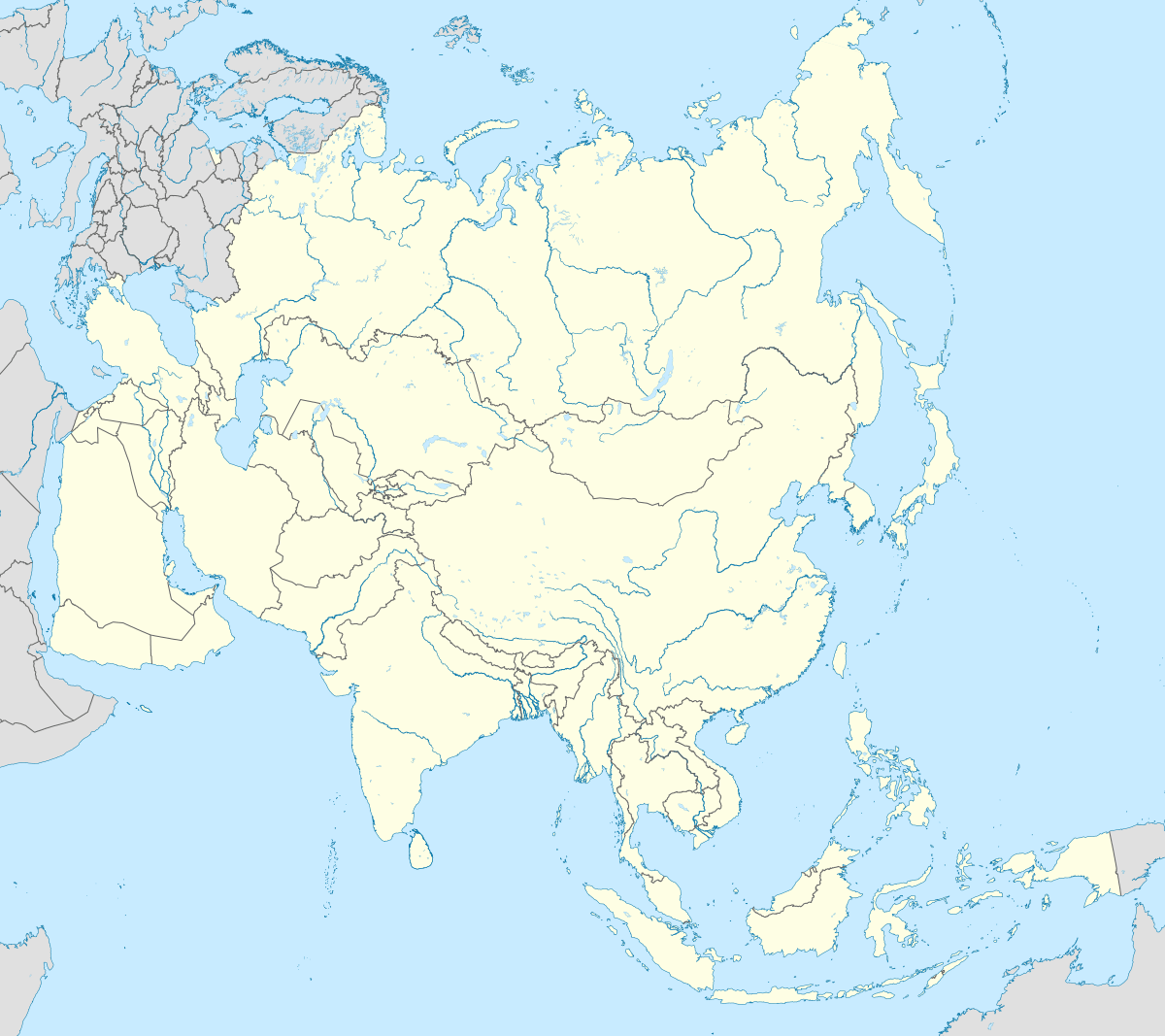
.svg.png)
